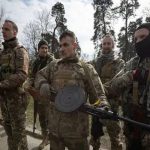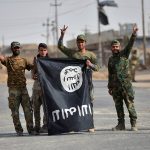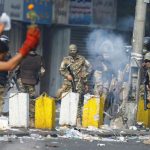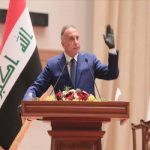TVC NEWS Pushing carts loaded with bags, babies and the elderly, hundreds of people fled Mosul on Saturday after Iraqi forces retook another district in the west of the city from Islamic State.
After walking for miles, families were taken by bus from a government checkpoint in the south of the city to camps housing more than 410,000 people displaced since the offensive to retake Mosul began in October.
“We left with no water, food or electricity,” said 63-year-old Abu Qahtan, the elder of a group of 41 people from five families. “We left with the clothes on our backs.”
Iraqi forces have taken much of Mosul from the militants who overran the city in June 2014.
The military now controls the eastern districts and are making advances in the west. Islamic State fighters are surrounded in the northwest and are using booby traps, sniper and mortar fire to defend themselves.
Artillery and gun fire could be heard as families arrived from Hay al-Tanak district which they said was still half controlled by the militants.
The U.S.-trained Counter-Terrorism Service (CTS) has retaken the nearby al-Thaura district, a statement said.
Hundreds of thousands of civilians are still trapped in western Mosul, where Iraqi forces are making slow progress against Islamic State in what is a labyrinth of narrow streets.
As of April 20, some 503,000 people have been displaced from Mosul, of which 91,000 have returned, a spokeswoman for the U.N. refugee agency UNHCR said, citing government figures. Mosul, Iraq’s second-largest city, is the militants’ last urban stronghold in the country.
TVC NEWS Pushing carts loaded with bags, babies and the elderly, hundreds of people fled Mosul on Saturday after Iraqi forces retook another district in the west of the city from Islamic State.
After walking for miles, families were taken by bus from a government checkpoint in the south of the city to camps housing more than 410,000 people displaced since the offensive to retake Mosul began in October.
“We left with no water, food or electricity,” said 63-year-old Abu Qahtan, the elder of a group of 41 people from five families. “We left with the clothes on our backs.”
Iraqi forces have taken much of Mosul from the militants who overran the city in June 2014.
The military now controls the eastern districts and are making advances in the west. Islamic State fighters are surrounded in the northwest and are using booby traps, sniper and mortar fire to defend themselves.
Artillery and gun fire could be heard as families arrived from Hay al-Tanak district which they said was still half controlled by the militants.
The U.S.-trained Counter-Terrorism Service (CTS) has retaken the nearby al-Thaura district, a statement said.
Hundreds of thousands of civilians are still trapped in western Mosul, where Iraqi forces are making slow progress against Islamic State in what is a labyrinth of narrow streets.
As of April 20, some 503,000 people have been displaced from Mosul, of which 91,000 have returned, a spokeswoman for the U.N. refugee agency UNHCR said, citing government figures. Mosul, Iraq’s second-largest city, is the militants’ last urban stronghold in the country.
TVC NEWS Pushing carts loaded with bags, babies and the elderly, hundreds of people fled Mosul on Saturday after Iraqi forces retook another district in the west of the city from Islamic State.
After walking for miles, families were taken by bus from a government checkpoint in the south of the city to camps housing more than 410,000 people displaced since the offensive to retake Mosul began in October.
“We left with no water, food or electricity,” said 63-year-old Abu Qahtan, the elder of a group of 41 people from five families. “We left with the clothes on our backs.”
Iraqi forces have taken much of Mosul from the militants who overran the city in June 2014.
The military now controls the eastern districts and are making advances in the west. Islamic State fighters are surrounded in the northwest and are using booby traps, sniper and mortar fire to defend themselves.
Artillery and gun fire could be heard as families arrived from Hay al-Tanak district which they said was still half controlled by the militants.
The U.S.-trained Counter-Terrorism Service (CTS) has retaken the nearby al-Thaura district, a statement said.
Hundreds of thousands of civilians are still trapped in western Mosul, where Iraqi forces are making slow progress against Islamic State in what is a labyrinth of narrow streets.
As of April 20, some 503,000 people have been displaced from Mosul, of which 91,000 have returned, a spokeswoman for the U.N. refugee agency UNHCR said, citing government figures. Mosul, Iraq’s second-largest city, is the militants’ last urban stronghold in the country.
TVC NEWS Pushing carts loaded with bags, babies and the elderly, hundreds of people fled Mosul on Saturday after Iraqi forces retook another district in the west of the city from Islamic State.
After walking for miles, families were taken by bus from a government checkpoint in the south of the city to camps housing more than 410,000 people displaced since the offensive to retake Mosul began in October.
“We left with no water, food or electricity,” said 63-year-old Abu Qahtan, the elder of a group of 41 people from five families. “We left with the clothes on our backs.”
Iraqi forces have taken much of Mosul from the militants who overran the city in June 2014.
The military now controls the eastern districts and are making advances in the west. Islamic State fighters are surrounded in the northwest and are using booby traps, sniper and mortar fire to defend themselves.
Artillery and gun fire could be heard as families arrived from Hay al-Tanak district which they said was still half controlled by the militants.
The U.S.-trained Counter-Terrorism Service (CTS) has retaken the nearby al-Thaura district, a statement said.
Hundreds of thousands of civilians are still trapped in western Mosul, where Iraqi forces are making slow progress against Islamic State in what is a labyrinth of narrow streets.
As of April 20, some 503,000 people have been displaced from Mosul, of which 91,000 have returned, a spokeswoman for the U.N. refugee agency UNHCR said, citing government figures. Mosul, Iraq’s second-largest city, is the militants’ last urban stronghold in the country.
TVC NEWS Pushing carts loaded with bags, babies and the elderly, hundreds of people fled Mosul on Saturday after Iraqi forces retook another district in the west of the city from Islamic State.
After walking for miles, families were taken by bus from a government checkpoint in the south of the city to camps housing more than 410,000 people displaced since the offensive to retake Mosul began in October.
“We left with no water, food or electricity,” said 63-year-old Abu Qahtan, the elder of a group of 41 people from five families. “We left with the clothes on our backs.”
Iraqi forces have taken much of Mosul from the militants who overran the city in June 2014.
The military now controls the eastern districts and are making advances in the west. Islamic State fighters are surrounded in the northwest and are using booby traps, sniper and mortar fire to defend themselves.
Artillery and gun fire could be heard as families arrived from Hay al-Tanak district which they said was still half controlled by the militants.
The U.S.-trained Counter-Terrorism Service (CTS) has retaken the nearby al-Thaura district, a statement said.
Hundreds of thousands of civilians are still trapped in western Mosul, where Iraqi forces are making slow progress against Islamic State in what is a labyrinth of narrow streets.
As of April 20, some 503,000 people have been displaced from Mosul, of which 91,000 have returned, a spokeswoman for the U.N. refugee agency UNHCR said, citing government figures. Mosul, Iraq’s second-largest city, is the militants’ last urban stronghold in the country.
TVC NEWS Pushing carts loaded with bags, babies and the elderly, hundreds of people fled Mosul on Saturday after Iraqi forces retook another district in the west of the city from Islamic State.
After walking for miles, families were taken by bus from a government checkpoint in the south of the city to camps housing more than 410,000 people displaced since the offensive to retake Mosul began in October.
“We left with no water, food or electricity,” said 63-year-old Abu Qahtan, the elder of a group of 41 people from five families. “We left with the clothes on our backs.”
Iraqi forces have taken much of Mosul from the militants who overran the city in June 2014.
The military now controls the eastern districts and are making advances in the west. Islamic State fighters are surrounded in the northwest and are using booby traps, sniper and mortar fire to defend themselves.
Artillery and gun fire could be heard as families arrived from Hay al-Tanak district which they said was still half controlled by the militants.
The U.S.-trained Counter-Terrorism Service (CTS) has retaken the nearby al-Thaura district, a statement said.
Hundreds of thousands of civilians are still trapped in western Mosul, where Iraqi forces are making slow progress against Islamic State in what is a labyrinth of narrow streets.
As of April 20, some 503,000 people have been displaced from Mosul, of which 91,000 have returned, a spokeswoman for the U.N. refugee agency UNHCR said, citing government figures. Mosul, Iraq’s second-largest city, is the militants’ last urban stronghold in the country.
TVC NEWS Pushing carts loaded with bags, babies and the elderly, hundreds of people fled Mosul on Saturday after Iraqi forces retook another district in the west of the city from Islamic State.
After walking for miles, families were taken by bus from a government checkpoint in the south of the city to camps housing more than 410,000 people displaced since the offensive to retake Mosul began in October.
“We left with no water, food or electricity,” said 63-year-old Abu Qahtan, the elder of a group of 41 people from five families. “We left with the clothes on our backs.”
Iraqi forces have taken much of Mosul from the militants who overran the city in June 2014.
The military now controls the eastern districts and are making advances in the west. Islamic State fighters are surrounded in the northwest and are using booby traps, sniper and mortar fire to defend themselves.
Artillery and gun fire could be heard as families arrived from Hay al-Tanak district which they said was still half controlled by the militants.
The U.S.-trained Counter-Terrorism Service (CTS) has retaken the nearby al-Thaura district, a statement said.
Hundreds of thousands of civilians are still trapped in western Mosul, where Iraqi forces are making slow progress against Islamic State in what is a labyrinth of narrow streets.
As of April 20, some 503,000 people have been displaced from Mosul, of which 91,000 have returned, a spokeswoman for the U.N. refugee agency UNHCR said, citing government figures. Mosul, Iraq’s second-largest city, is the militants’ last urban stronghold in the country.
TVC NEWS Pushing carts loaded with bags, babies and the elderly, hundreds of people fled Mosul on Saturday after Iraqi forces retook another district in the west of the city from Islamic State.
After walking for miles, families were taken by bus from a government checkpoint in the south of the city to camps housing more than 410,000 people displaced since the offensive to retake Mosul began in October.
“We left with no water, food or electricity,” said 63-year-old Abu Qahtan, the elder of a group of 41 people from five families. “We left with the clothes on our backs.”
Iraqi forces have taken much of Mosul from the militants who overran the city in June 2014.
The military now controls the eastern districts and are making advances in the west. Islamic State fighters are surrounded in the northwest and are using booby traps, sniper and mortar fire to defend themselves.
Artillery and gun fire could be heard as families arrived from Hay al-Tanak district which they said was still half controlled by the militants.
The U.S.-trained Counter-Terrorism Service (CTS) has retaken the nearby al-Thaura district, a statement said.
Hundreds of thousands of civilians are still trapped in western Mosul, where Iraqi forces are making slow progress against Islamic State in what is a labyrinth of narrow streets.
As of April 20, some 503,000 people have been displaced from Mosul, of which 91,000 have returned, a spokeswoman for the U.N. refugee agency UNHCR said, citing government figures. Mosul, Iraq’s second-largest city, is the militants’ last urban stronghold in the country.











